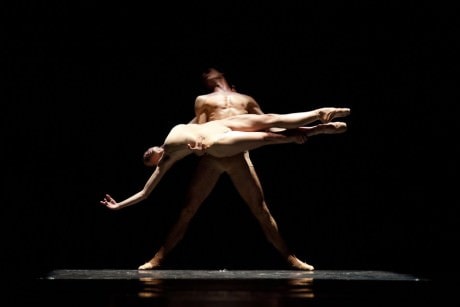Grey, almost nondescript costumes, would not seem powerful. A lightly lit modern painting, blue, then back to grey, would not seem striking. Eight dancers, re-entering in lines from upstage to downstage, walking toward the audience, may not sound breathtaking; but “Adagio & Scherzo,” the first piece from the Polish National Ballet in their Washington, D.C. debut, choreographed by Director Krzysztof Pastor, spoke volumes through controlled dance language.

Walking toward the audience, for this company, became peeling through, or perhaps back, the shadows. All arms intertwined as the dancers formed a circle center stage, pulsed together, then separated, only to return to this strong, unified shape several more times. A pas-de-deux unfolds downstage left, while another stays paused, upstage right, until the melody and the movement pass to it and signal its beginning. Schubert’s lyrical String Quintet in C Major chords tether the relationships. This is very much an ensemble interaction, bolstered by individual strengths but powerful in its complete state: eight dancers on stage, at once. “Adagio” affords each dancer to carve his or her own impression on the audience, so that the group “Scherzo,” becomes a joyful party of familiar faces, rather than a celebration trespassed.
In “Scherzo,” the company smiles; a male dancer makes a hoop with his hands for a female dancer’s leg held in developpé; it is play, made possible through rigorously mastered technique, made all the more enjoyable to witness given the lyrical touches of the previous movement.
Uplifting spirits morph downward in Emanuel Gat’s take on Stravinsky’s iconic Le sacre du printemps. The familiar oboe ebbs into—a dark stage, and five dancers discolored by red light. Someone is missing, a partner for the fifth dancer, creating a sense of discord from the start. Once again, the Polish Ballet defies expectations: five dancers would not seem disturbing. Their opening sequence, reminiscent of a salsa step, then goes on to haunt the proceedings, which recall a limbo, or purgatory. Though the dancers move away from that sequence, it always circles back, sometimes to a slower tempo, but—always. In one moment, a male dancer’s arm begins to rise, to signal its start again, and once again: intrigue. A raised arm is not a raised arm, but a menacing omen. A female dancer as far downstage as she can be, turns her back to the audience, twists her free hair into a low bun, moves to center stage and that red light once more, and sinks slowly to lying on the floor. In the aftermath of the frenetic energy of these five, tortured spirits, the effect is ominous.
Pastor’s “Moving Rooms,” closed the evening but worked like a door left open to “Rite of Spring.” A similar sense of unrest wafted in, coating the dance in the same subtle discord. The beauty, however, lies in the harmony of the ensemble. Where this energy radiated without obstacle in “Adagio & Scherzo,” now it communicates despite, and against, those same shadows. A journey has taken place—broadly, from calm to strife to the inevitable strength that comes from moving on. A clear expression.
Running Time: 2 hours, including two intermissions.
The Polish National Ballet performed Tuesday, June 23, 2015 in the Eisenhower Theater at the John F. Kennedy Center for the Performing Arts -2700 F Street NW, in Washington, DC. For future events, go to their website.




